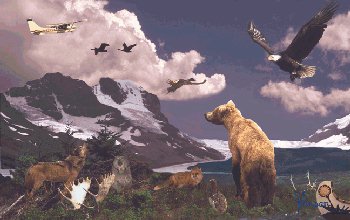The profound effect of the ecozone’s climate on wildlife is especially apparent during late summer, when many species migrate south to avoid the abrupt transition to cooler autumn weather and the long cold winters that follow. Moose and Caribou are the most abundant and widespread ungulates. Valley bottoms provide the best winter range for both species, but much of this ecozone is abandoned by mid-winter because of deep snow. Mountain Goats are year-round inhabitants and tend to avoid the deep snow because of the steep terrain they inhabit. Stone Sheep are found on steep south-facing grasslands associated with rugged terrain. Dall Sheep, Grizzly Bear and Black Bear are also present. Other typical forest species are the Spruce Grouse, Common Raven, Gray Jay, Boreal Chickadee, Red-breasted Nuthatch, Three-toed Woodpecker, Ruby-crowned Kinglet, Red Squirrel, Wolverine and Marten.
No reptiles are present and the Western Toad, Wood Frog and Spotted frog are the only amphibians.
The many open and shrubby valley bottoms are important as summer range for Moose and Caribou, but are too exposed and snowy to be used as winter range. The Willow Ptarmigan, Arctic Ground Squirrel and Wilson's Warbler are common in these areas.
